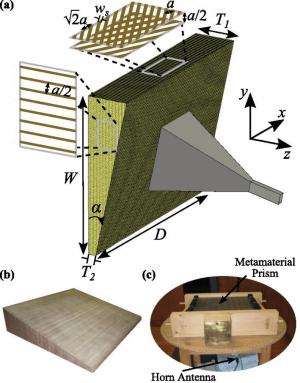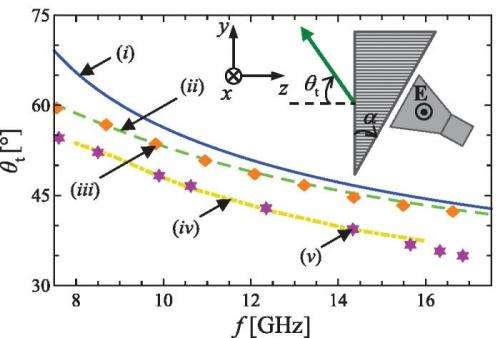January 9, 2015 feature
Metamaterial prism creates a reverse rainbow

(Phys.org)—In a normal rainbow, red is always on "top" while violet is on the "bottom." This is true whether the rainbow is created by a glass prism or by water droplets in the sky, and is due to the way that these materials refract light of different wavelengths: colors with longer wavelengths (red) are less refracted/bent than colors with shorter wavelengths (violet). Now in a new study, scientists have designed a prism that does the opposite: it refracts longer wavelengths more strongly than shorter wavelengths. The result is a reverse rainbow.
The researchers, Tiago A. Morgado, et al., from the University of Coimbra, the University Institute of Lisbon, and the University of Lisbon, all in Portugal, have published their paper on creating a reverse rainbow in the microwave part of the spectrum using the new prism in a recent issue of Applied Physics Letters.
The new prism is made of metamaterials, which are man-made materials that have properties not typically found in natural materials. In this case, the atypical property is non-local topology, which gives rise to the stronger refraction of longer wavelengths and the reverse rainbow.
As the scientists explain, natural crystalline materials such as glass and water have a local structure, in which the atoms lie isolated at lattice points and mainly interact only with their nearest neighbors. In contrast, atoms in the new metamaterial are all interconnected by crossed metallic wires. In the resulting non-local structure, each atom's response to light is fundamentally entangled with the responses of other atoms, even those located far away in the crystal.
This nonlocal, interconnected response of the atoms changes the way that the metamaterial disperses different frequencies of light, producing an effect called "anomalous dispersion." The anomaly is that the refractive index of the material, and therefore the transmission angle of the light, increases as frequency decreases. This is the opposite of what happens in a conventional glass prism or water droplets.

The scientists demonstrated in both experiments and simulations that the nonlocal metamaterial can create a reverse rainbow. Their prototype consists of a stack of 297 printed circuit boards printed with 0.25-mm-wide metallic strips to connect the atoms' responses. Although the prototype operates only in the microwave region, the phenomenon could also be demonstrated in the visible and other parts of the spectrum in future experiments.
"We are currently exploring ways of implementing our nonlocal material at optical frequencies," coauthor Mario Silveirinha, Professor at the University of Coimbra, told Phys.org. "This is rather challenging from a technological point of view, but we are convinced that it can be done."
Besides creating a reversed rainbow, the metamaterial and its property of anomalous dispersion could have other useful applications. One use is improving optical instruments by decreasing image distortions.
"Because of the normal material dispersion, conventional single-material glass lenses are unable to focus all the spectral components of light into the same point, even in ideal circumstances where the effects of diffraction are negligible," Silveirinha said. "Hence the image produced by a glass lens may have distortions, and in such a case the optical system is said to suffer from chromatic aberrations.
"An interesting possibility created by an anomalous material dispersion is the correction of chromatic aberrations. We have shown that by capping a conventional glass lens with normal material dispersion with a suitably designed metamaterial with anomalous dispersion, it may be possible to suppress the effects of material dispersion, and eliminate the chromatic aberrations for all light wavelengths. This may provide an exciting route for improved optical instruments insensitive to chromatic aberrations. Other promising applications of these nonlocal metamaterials include ultra-subwavelength waveguiding and focusing with planar lenses based on negative refraction."
More information: Tiago A. Morgado, et al. "Reversed rainbow with a nonlocal metamaterial." Applied Physics Letters. DOI: 10.1063/1.4905152
Journal information: Applied Physics Letters
© 2015 Phys.org




















